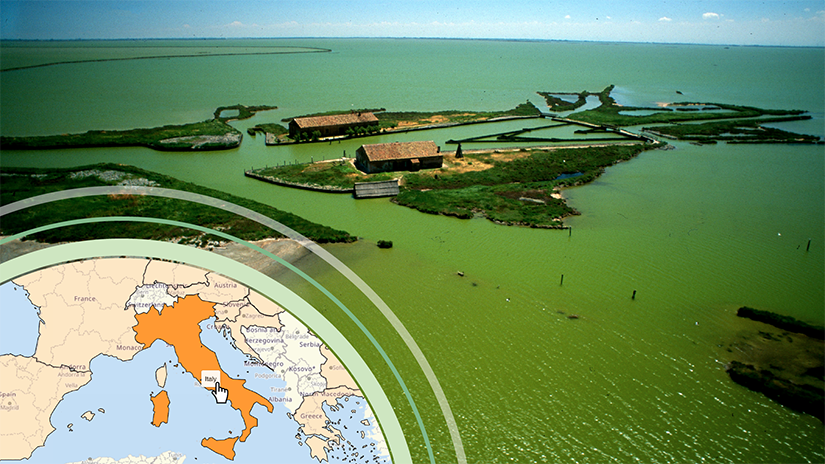Background information

Kasvatatavate liikide liik
Vahemere rannakarp (Mytilus galloprovinvialis), Manila clam (Ruditapes philippinarum), vaikne austr (Crassostrea gigas), Rainbow Trout (oncorhynchusmykiss), Salmonid (mitu liiki), hiltpea-meriraam (Sparus aurata), harilik huntahven (Dicentrarchus labrax), Meagre (Argyrosomus regius), karpkala (mitu liiki), tuuralised (mitu liiki), euroopa angerjas (Anguilla anguilla), kassi kalad (Aeiurus melas, A. punctatus).
Päritolu: 2021, akvakultuuri andmete kogumine, määrus 762/2008
Tootmismeetodi liik
2021. aastal toimus 69,7 % Itaalia toodangust mere- ja riimvees ning 30,3 % magevees. Kasutati järgmisi peamisi tootmismeetodeid:
Sektori suurus (tootmine ja tarbimine)
Päritolu: 2021, akvakultuuri andmete kogumine, määrus 762/2008; 2023, EUMOFA
Suundumused (varasemad ja tulevased)
2021.–2027. aasta riiklikus vesiviljeluse strateegilises kavas aastateks 2021–2027 määrati Itaalia vesiviljeluse arendamiseks kindlaks kaheksa prioriteeti ja 4 peamist eesmärki vastavalt Euroopa strateegiatele „Roheline kokkulepe“, „Talust taldrikule“, „Bioloogiline mitmekesisus“ ja „ELi vesiviljeluse kestlikkuse ja konkurentsivõime suurendamise strateegilised suunised aastateks 2021–2030“ (COM(2021) 236 final).
Itaalia ametiasutuste määratletud prioriteedid on järgmised:
- bioloogilise mitmekesisuse säilitamine;
- koordineeritud mereruumi planeerimine;
- loomatervis ja loomade heaolu;
- teadusuuringud ja digitaliseerimine;
- tarbijate teadlikkus ja sotsiaalne vastuvõetavus;
- piirkondlike haldusasutuste strateegilise rolli tugevdamine;
- kogukonna juhitud kohalik areng; 8) rahvusvaheline koostöö.
Neli peamist eesmärki, mis tuleb saavutada:
- Korraldus nr 1 „Institutsioonilise suutlikkuse tugevdamine ja haldusmenetluste lihtsustamine“;
- MO2 „Vesiviljeluse arengu ja jätkusuutliku kasvu tagamine koordineeritud ruumilise planeerimise ja alade potentsiaali suurendamise kaudu“;
- MO3 „Vesiviljeluse konkurentsivõime edendamine“;
- MO4 „Ettevõtjate jaoks võrdsete võimaluste edendamine ja vesiviljelustoodete turu korralduse parandamine“.
Päritolu: NSPA 2021–2027
Vesiviljeluse mõju riigi majandusele, toiduainete turule ja tööturule
- Eurostati andmetel (2020) moodustas Itaalia 2019. aastal 11,3 % ELi vesiviljelustoodangu mahust, mis on Hispaania, Prantsusmaa ja Kreeka järel neljandal kohal.
- Viimaste kättesaadavate andmete kohaselt vähenes vesiviljelus 2018. aastal kogutulus –3 %. Tegevuskulud suurenesid + 10 %, nagu ka tööjõukulud. Selle tulemusel vähenes kogulisandväärtus 11 %. 2018. aastal algatasid peaaegu kõik Itaalia piirkonnad enamiku Euroopa Merendus- ja Kalandusfondi (EMKF) abitaotlustest seoses meetmega 2.48 – Tootlikud investeeringud vesiviljelusse. See näitas sektori valmisolekut töötada peamiselt vertikaalse integratsiooni nimel, investeerides ümberkujundamistegevusse, aga ka uutesse turundusvormidesse ja väärtusahela integreerimisesse.
- Itaalias kasvatatakse vesiviljelust, kus domineerib piiratud arv liike, nagu rannakarp, karpkala, vikerforell, huntahven ja merikogerlased, mitmesugustes eri keskkondades, kus tehnoloogia areng on erinev, ning seda iseloomustavad kohalike traditsioonidega tihedalt seotud põllumajandustavad, nagu „vallicoltura“ ja karpide kasvatamine laguunides.
- Tootmise vähest mitmekesistamist peetakse sektori üldise ebakindluse üheks põhjuseks, mis tuleneb suuremast sisemisest kaubanduslikust konkurentsist esindamata või alaesindatud toodete suhtes ja suurenevast impordist.
- Itaalias on väga oluline ka inimtoiduks ettenähtud munade tootmine. Tuuramunad (kaaviar), lõhelaste munad ja meripoisuri munad (roe).
- Mahepõllumajanduslike vesiviljelustoodete tarbimine on äärmiselt piiratud teabe puudumise tõttu toodete ja tootmisprotsesside kohta, mahepõllumajanduslikult sertifitseeritud noorkalade ebapiisava pakkumise ja suurte sertifitseerimiskulude tõttu.
Päritolu: NSPA 2021–2027
Probleemid ja võimalused
- Vesiviljeluse jaoks on vaja standardseid ja lihtsustatud menetlusi.
- Riiklike toodete konkurentsivõime suurendamine rahvusvahelistel turgudel.
- Vähendada negatiivset mõju bioloogilisele mitmekesisusele, piirates kudema jõudmise ohtu; ranniku eutrofeerumine ja sellest tulenevad muutused looduslike kogukondade struktuuris; taudi ülekandumine põllumajandusloomadelt metsloomadele; võõrliikide sissetoomine; vesiviljelustegevuse arendamiseks väärtuslike looduslike elupaikade hävitamine.
- Parandada rannikualade ja märgalade ruumilist planeerimist ja maakasutust, et vähendada konflikte rannikul toimuvate eri tegevuste vahel.
- Veterinaarravimite üha vastutustundlikumat kasutamist toetavate meetmete parandamine, sealhulgas söödas rakendatavate funktsionaalsete koostisosade uurimine ning tõhusate ja uuenduslike vahendite väljatöötamine kalahaiguste diagnoosimiseks, ennetamiseks ja raviks.
- Teadusuuringute ja digitaliseerimise edendamine teaduslike ja tehniliste teadmiste, uuenduslike tavade ja võrgustike loomise ning ettevõtete, kutseorganisatsioonide ja muude sidusrühmade, sealhulgas teadus- ja tehnikaasutuste vahelise kogemuste ja heade tavade vahetamise kaudu.
- Parandada tarbijate teavitamist, et suurendada vesiviljeluse sotsiaalset vastuvõetavust. Dialoogi edendamine sidusrühmadega, et suurendada nende teadlikkust protsessi ja toote sertifitseerimise eelistest.
- Kogukonna juhitud kohalik areng – kogukonna juhitud kohalik areng: Kalanduse kohalikel tegevusrühmadel on keskne roll kohaliku ja piirkondliku vesiviljeluse arengu edendamisel.
- Vesiviljeluse kasumlikkuse parandamise ja sellest tuleneva tööhõive suurendamise meetmete stimuleerimine.
- Uute rajatiste avamine, jätkates samal ajal olemasolevate rajatiste ajakohastamist, parandades nende keskkonnasäästlikkust ja rahalist jätkusuutlikkust seoses tootmise tulemuslikkuse ja energiatõhususega.
- Tervete ja tootlike veeökosüsteemide säilitamine.
- Investeerimine töötajate kutsealasesse koolitusse ja arengusse ning elukestvasse õppesse.
- Säästvate ja vähese mõjuga tavade suurendamine, seades prioriteediks näiteks madala troofilise ja multitroofse vesiviljeluse, vetikakasvatuse ja mahepõllumajandusliku vesiviljeluse.
- Uute tehistingimustes peetavate liikide kasutuselevõtt.
- Toetada toodete diferentseerimist, et suurendada lisaväärtust.
- Töötada välja uued taskukohased ja kasutajasõbralikud digivahendid (riist- ja/või tarkvara), et tagada toodete jälgitavus ja põllumajandusettevõtte juhtimine.
- Luua spetsialiseeritud teadusinstituute ning arendada koostoimet teadusuuringute ja ettevõtete vahel, et luua ja levitada jätkusuutlikke vesiviljelusmudeleid.
- Toidu, ravimite ja kosmeetikatoodete, rohelise saastest puhastamise ensüümide, biolagunevate materjalide jms võimalike pähkli- ja funktsionaalsete ainete allikate kindlakstegemine.
- Sertifitseeritud kohalike toodete pakkumise stimuleerimine päritolunimetuste abil.
Päritolu: NSPA 2021–2027
Tööhõive ja ettevõtete arv
2021. aastal 504 ettevõtet (679 töötavat tehast); sektori kogutööhõive oli 2017. aastal 44488.
Päritolu: NSPA 2021–2027
Multi-annual National Strategic Plans for the development of sustainable Aquaculture
Relevant Authorities
Applicable Legislation
- Seadusandlik pädevus vesiviljeluse valdkonnas on piirkondadel, samal ajal kui riik vastutab riikliku programmitöö ja regionaalpoliitika koordineerimise eest.
- 5.veebruari 1992. aasta seadus nr 102 vesiviljeluse kohta (muudetud 27. märtsi 2001. aasta seadusega nr 122)
- 18.mai 2001. aasta seadusandlik dekreet nr 226, millega kehtestatakse suunised kalandus- ja vesiviljelussektori ajakohastamiseks, muudetud 2004. aasta seadusandliku dekreediga nr 154
- 4. augusti 2008. aasta seadusandlik dekreet nr 148: Direktiivi 2006/88/EÜ (vesiviljelusloomade ja vesiviljelustoodete loomatervishoiunõuete ning teatavate veeloomadel esinevate taudide ennetamise ja tõrje kohta) rakendamine
- Ministri 8. juuli 2010. aasta dekreet, Seadusandlik dekreet nr 148: Vesiviljelustootmisettevõtete registrit käsitlevad sätted
- Ministri 3. augusti 2011. aasta dekreet, Seadusandlik dekreet nr 148: Sätted, mis käsitlevad veterinaarlubade väljastamist vesiviljelusettevõtetele ja töötlemisettevõtetele 4. augusti 2008. aasta seadusandliku dekreedi nr 148 artikli 6 tähenduses
- Ministri 4. veebruari 2020. aasta dekreet nr 7630: „Säästva vesiviljeluse“ tootmisspetsifikaati tunnustamine põllumajandus- ja metsanduspoliitika ministeeriumi poolt tunnustatud riiklikus zootehnilises kvaliteedisüsteemis, ministri 4. märtsi 2011. aasta dekreet nr 4337
Applicable Procedures
Keskkonnamõju hindamine ( seadusandlik dekreet nr 152/2006, mida on hiljuti muudetud seadusandliku dekreediga nr 104/2017, millega võetakse üle direktiiv 2014/52/EL teatavate riiklike ja eraprojektide keskkonnamõju hindamise kohta)
National associations and networks
Relevant Websites
- Vesiviljelusplatvorm (Itaqua)
- Riiklik statistikainstituut (ISTAT)
- CREA – Loomakasvatus ja vesiviljelus (täpsustada asjakohane teave ka siin)
